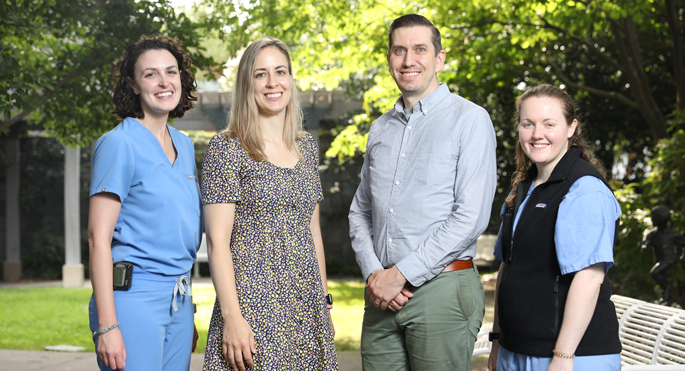
by Nancy Humphrey
Foreign bodies, like coins, button batteries, tiny magnets and sharp objects, were more frequently ingested by children during the coronavirus pandemic than in the same months the year before, according to a single-center study conducted at Monroe Carell Jr. Children’s Hospital at Vanderbilt.
The study, conducted by Katherine Black, MD, Lauren Klein, MD, Michael Dole, MD, and Danielle Orsagh-Yentis, MD, reviewed the charts of 72 patients younger than 18 presenting to Children’s Hospital’s emergency department, inpatient consult service or endoscopy suite. Ingestions of foreign bodies were confirmed via chart review. One patient ingested two different foreign bodies.
The review found that 42 children seen at Children’s Hospital ingested foreign bodies from March to July 2020 (during the pandemic) compared to 30 in the same months of 2019, pre-pandemic. The frequency of ingestion differed significantly in May 2020, with 12 ingestions per 31 days, compared to five ingestions per 31 days in May 2019.
More children in the 1- to 6-year-old range ingested foreign bodies; and males in both groups were more likely to ingest. Coins were the most frequently ingested foreign body during both time frames.
Orsagh-Yentis said the idea for the study came to her when she was on call during one of the early weeks of the pandemic and noticed what appeared to be more than the usual number of calls for consultations for foreign body ingestion.
She consulted with the fellows in her group — Black and Klein — and with Dole and determined they should compare the two time periods, beginning on March 5, which was the day the first case of COVID-19 was reported in Tennessee.
“It made me think, ‘is this related to the pandemic in some way, to an alteration in home life and how everybody is going about their day?’ Many caregivers have taken on new roles — teachers, full-time caregivers and working from home. Changes to daily routines may have altered risk factors for foreign body ingestion,” she said.
“We know from our own colleagues who are parents who were working full time were still having to do their jobs, still having to take care of their kids, and they probably had to take on some educational responsibilities at home.”
Overall, the rate of foreign body ingestion in children is increasing, Orsagh-Yentis said.
A large-scale study showed that from 1995 to 2015 there was a dramatic rise in foreign body ingestions. About 20% of children ages 1-3 years have ingested a foreign body.
“We know that children explore the world with their mouths. They like to take that shiny object and put it in their mouths,” she said. “Most of the time those foreign bodies are going to move through the GI tract without causing any damage, but we’re also seeing an increase of really scary ingestions like button batteries and small rare-earth magnets (the strongest type of permanent magnet) that can cause significant damage to the tissue, morbidity and mortality.
“Some of these tiny magnets have such a strong affinity and pull for one another that they will try to connect to one another no matter where in the body they are. So, you can imagine if one is in one part of the intestine, and the other further down, they will still try to find each other. They can go through intestinal lining and cause fistulas (tracts from one piece of intestine to another). There’s a very serious potential for danger there.”
Orsagh-Yentis said the location of the foreign body in the gastrointestinal tract also differed significantly on the initial abdominal X-ray during the two time periods. Pre-COVID, the majority of foreign bodies were identified in the esophagus. During the months of 2020, more foreign bodies were identified in the stomach, although this finding did not have statistical significance.
“That’s interesting about timing. To us, that indicates they were presenting a bit later following their ingestion, and once the ingested foreign body is in the stomach and beyond, there’s a lesser need for urgent endoscopic removal.”
The reason for later presentation isn’t entirely known, but it could be because caregivers may have been hesitant to bring their children into the hospital during the pandemic or because their primary care providers may have indicated that they could wait, she said.
There were also fewer endoscopies performed during the pandemic. Endoscopies are used to access foreign bodies and remove them from the gastrointestinal tract. Endoscopy was performed for 70% of foreign bodies prior to the pandemic, compared to 52% during the pandemic.
Orsagh-Yentis said there are some preventive safety measures that parents can put in place to make sure tiny objects are kept away from young children.
- Always keep tiny objects, particularly dangerous ones like button batteries and magnets, in a high, locked cabinet.
- Ensure that batteries are in secured compartments.
- If you see that something is missing from a toy — particularly batteries or high-affinity magnets — contact your child’s pediatrician. If your child is complaining of abdominal pain, vomiting, or if the child’s abdomen is distended (larger than typical size), call the pediatrician.
- If you know for sure a foreign body has been ingested, take your child to the emergency department. And if you have the packaging of whatever your child has ingested, bring it along. “That’s very helpful for us. Knowing what it is can be very helpful in determining timing or necessity of further work up,” she said.












